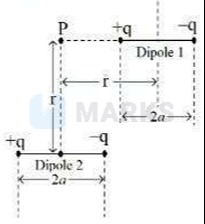Question
Question: p +q -q Dipole 1 r 2a -q +q Dipole 2 2a ...
p
+q -q
Dipole 1
r
2a
-q +q
Dipole 2
2a

The potential energy is U=4πϵ0142r3p2
The potential energy is U=−4πϵ0142r3p2
The potential energy is U=−4πϵ0142r33p2
The potential energy is U=4πϵ0142r33p2
- \frac{1}{4\pi\epsilon_0} \frac{p^2}{4\sqrt{2} r^3}
Solution
The interaction potential energy U between two dipoles p1 and p2 separated by a vector R is given by: U=4πϵ01(R3p1⋅p2−3R3(p1⋅R^)(p2⋅R^)) Assuming Dipole 2 is at the origin (0,0) with its dipole moment along the x-axis, p2=pi^. The diagram suggests that Dipole 1 is positioned such that its center is at (r,r). If we assume Dipole 1 is also oriented along the x-axis, parallel to Dipole 2, then p1=pi^. The vector connecting the centers of the dipoles is R=ri^+rj^. The magnitude of this vector is R=∣R∣=r2+r2=r2. The unit vector in the direction of R is R^=RR=r2ri^+rj^=21(i^+j^).
Now, we compute the dot products: p1⋅p2=(pi^)⋅(pi^)=p2 p1⋅R^=(pi^)⋅(21(i^+j^))=2p p2⋅R^=(pi^)⋅(21(i^+j^))=2p
Substitute these into the potential energy formula: U=4πϵ01((r2)3p2−3(r2)3(2p)(2p)) U=4πϵ01(r3(22)p2−3r3(22)2p2) U=4πϵ01r3(22)p2(1−23) U=4πϵ01r3(22)p2(−21) U=−4πϵ0142r3p2 This result assumes that both dipoles are aligned parallel to each other and pointing in the same direction. The diagram's charge distribution (+q on left, -q on right) for both dipoles suggests a horizontal orientation, and the label 'p' without an arrow on Dipole 1 could imply its moment is also horizontal. The upward arrow next to 'p' on Dipole 1 in the diagram is ambiguous and is disregarded in favor of the charge distribution for determining dipole orientation. The magnitude p is given by q×2a.
